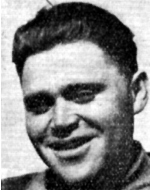Mostwilisker-Gesri, Shraga (Jehoshaphat)
Son of Miriam and Aryeh, was born on January 20, 1914 in the city of Soli, Poland, where he studied elementary and secondary studies. Impatient to wait years until his turn to receive a “certificate” (immigration permit) immigrated to Israel in 1933 and joined the Ginnegar group in the Jezreel Valley. Where he established a family and had two children. In addition to his activities in the Hagana and the local security committee, he participated in the organization of illegal immigration (for the first time in bringing the ship “Velos” in 1935). During the bloody riots of 1936-1939, he served as a sergeant with the rank of sergeant (sergeant), and in 1938 he participated in organizing and carrying out the security aspects of the aliyah to Hanita. During the years 1942-1944 he was active in the Palmach organization, in command and training, and during the struggle in 1946 he participated with his Palmach members in the bombing of the bridges and other activities. His name in the Haganah underground was “Jehoshaphat”. He would return to the shovel and the plow, and would work as a member of the group. When the United Nations General Assembly decided on 29 November 1947 to divide the country into two states, he took up full service and was appointed commander of the Zevulun district, which included the Krayot in the Haifa Bay, where he met the difficult tests of a military man and a diplomat. Security personnel were trained and equipped, and on the other hand it was necessary to transfer young people (during the recruitment process) to the Hish battalions that were established and weapons from the inventory of local Hagana units. With the ability of diplomatic persuasion and endless labor, the district commander managed to coordinate the two basic tasks that were contrary to one another. The local Haganah battalions organized elderly people and managed to “confiscate” them by force of persuasion, the weapons needed by the infantry battalions. Which they also need. In particular, it should be noted that Shraga’s operation was planned to ambush the large convoy of weapons to the Arabs of Haifa in Kiryat Motzkin. Shraga was a member of the Hagana council of Haifa. After his many entreaties, he was finally transferred to a combat command as deputy commander of the Carmeli Brigade and participated in the liberation of Haifa, the battles of Balad al-Sheikh and the liberation of Acre and the Western Galilee. From there he was transferred with his battalion to the Jenin sector. After stopping the invasion of the Jordan Valley, our forces took the initiative and attacked the Gilboa area. After gaining control of the Gilboa ridge, the Carmeli Brigade attacked Jenin on the night of June 2-3 and occupied the outposts controlling the city. The Iraqi army, which had moved to Samaria after its failure in the Jordan Valley, concentrated its forces and counterattacked and our forces were forced to withdraw. In this battle he fell, along with his friends, by a shell hit the headquarters of the battalion during the meeting of the staff on May 3, 1948. After his death he was granted the rank of captain. In Acre, a street and a house of people on the same street were named after him (Jehoshaphat). “Shraga Camp” is named after him. On the 20th of Av 5710 (13.8.1950) he was transferred to eternal rest in the military cemetery on Mount Herzl in Jerusalem.
